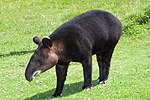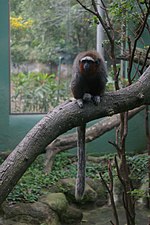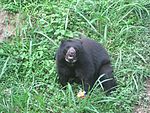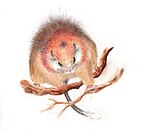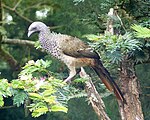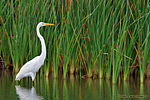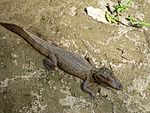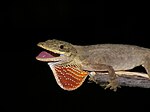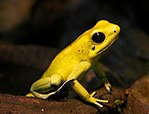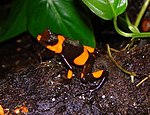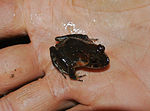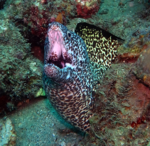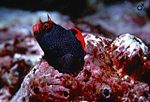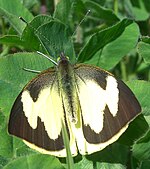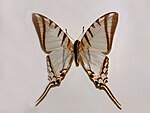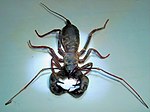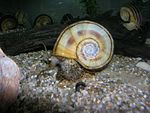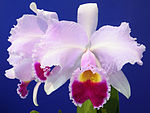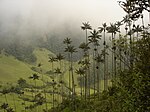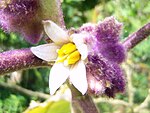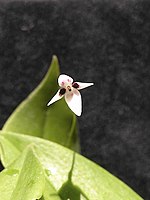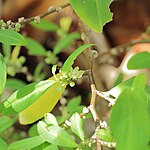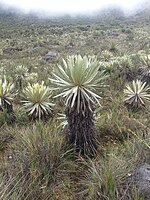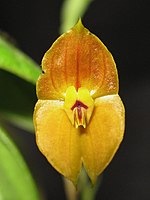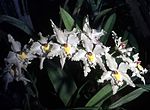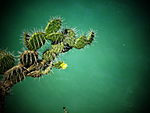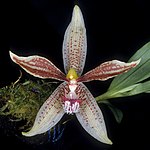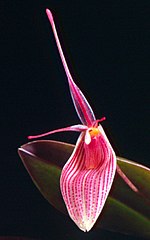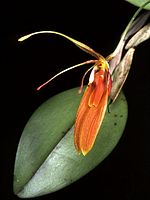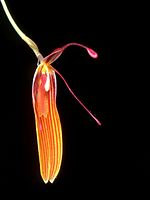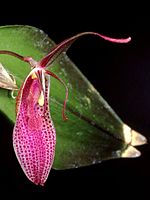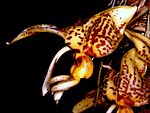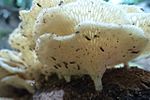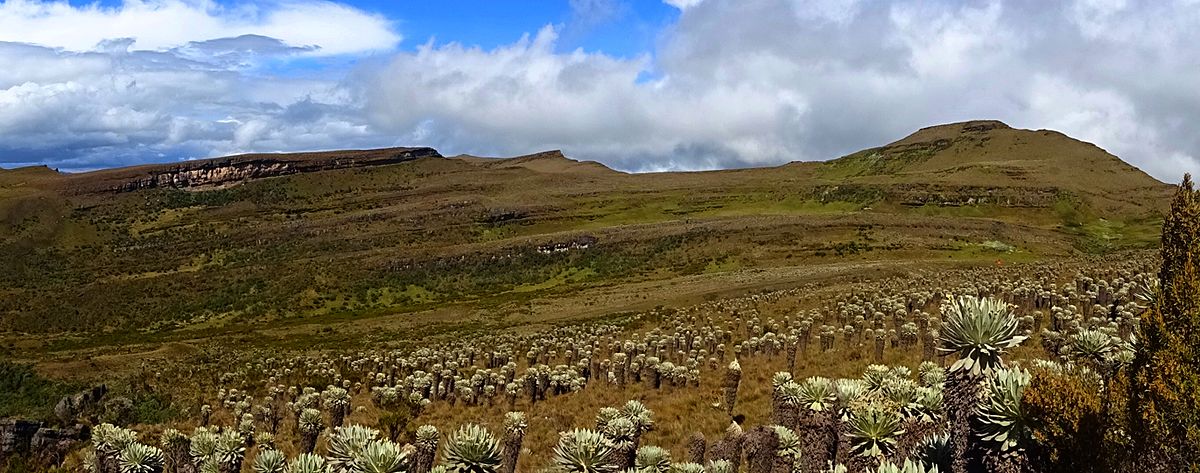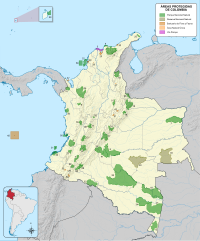Biodiversity of Colombia
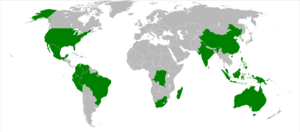

1 - Tropical Andes
5 - Tumbes-Chocó-Magdalena

The biodiversity of Colombia is the variety of indigenous organisms in the country with the second-highest biodiversity in the world, behind Brazil.[1] As of 2016, 56,343 species are registered in Colombia, of which 9,153 are endemic. The country occupies the first position worldwide in number of orchids and birds, second position in plants, amphibians, butterflies and fresh water fish, third place in species of palm trees and reptiles and globally holds the fourth position in biodiversity of mammals.
The country hosts 59 nationally designated protected areas. At the establishment of the most recent addition, Bahía Portete – Kaurrele National Natural Park, Colombian president Juan Manuel Santos said "Biodiversity is to Colombia, what oil is for the Arabs".[2][3]
In 2019, according to the Colombian Biodiversity Information System, 62,829 species were registered in the country, 5 of which more than 9,000 are considered endemic species.6 7 8 The country occupies the first position in the world in number of orchid and bird species, second in plants, amphibians, butterflies and freshwater fish, third in palm and reptile species, and fourth in mammalian biodiversity.
According to a report by the WWF, half of Colombia's ecosystems are in a critical state of deterioration or in a state of danger. The organization said that environmental degradation is due to oil extraction, mineral and metal extraction and deforestation. Deteriorating ecosystems are threatening the existence of more than a third of Colombia's plants and 50 percent of its animals.[4]
Since 1998, the Humboldt Institute for Biological Resources has been collecting biodiversity samples. As of 2014, 16,469 samples, representing around 2,530 species of 1,289 genera, and 323 families from Colombian biodiversity have been stored in its archives. [5]
Description[]
Colombia is one of seventeen megadiverse countries in the world.[6] The country in northwestern South America contains 311 types of coastal and continental ecosystems.[1] As of 2016, a total of between 56,343 and 56,724 species are registered in the country,[7][8] with 9153 endemic species.[9] Colombia is the country with the most páramos in the world; more than 60% of the Andean ecosystem is found within Colombian territories.[10] Boyacá is the department where 18.3% of the national total area is located.[11] Since December 20, 2014, Colombia hosts 59 protected areas.[12] The biodiversity is highest in the Andean natural region, followed by the Amazon natural region.[13] Since 1998, the Humboldt Institute for Biological Resources in the country has been collecting samples of biodiversity. As of 2014, 16,469 samples, representing around 2530 species from 1289 genera, and 323 families of the Colombian biodiversity have been stored in their archives.[14]
The biodiversity of Colombia is at risk, mainly because of habitat loss, urbanisation, deforestation and overfishing.[15] According to a study of 2001, 260,000 hectares (640,000 acres) of forested area is lost every year.[16] Around 1200 species are critically endangered,[17] and 922 species are introduced in Colombia, 22 of which are classified as invasive species in Colombia.[18] Various plans to address the environmental issues are proposed.[19] The National System of Protected Areas (SINAP) is the administrator of protected areas.
Biodiversity in numbers[]
| Class | Group | Pos | hideSpecies |
|---|---|---|---|
| Vertebrates | Mammals (list, primates) | 4 | 492
|
| Birds (list, endemic) | 1 | 1941
| |
| Reptiles (list, lizards, snakes) | 3 | 537
| |
| Amphibians | 2 | 803
| |
| Marine fish | 2000
| ||
| Freshwater fish (Magdalena River) | 1435
| ||
| Invertebrates (arthropods) |
Lepidoptera (butterflies, ) | 1 | 3274
|
| Ants | 900
| ||
| Marine molluscs | 1250
| ||
| Marine sponges | 1250
| ||
| Corals | 139
| ||
| Marine decapods | 560
| ||
| Echinoderms | 296
| ||
| Terrestrial molluscs | 650
| ||
| Beetles | 7000
| ||
| Arachnids | 1089
| ||
| Bees | 398
| ||
| Diptera | 3153
| ||
| Flora (endemic) | Flowering plants | 22,840
| |
| Flowerless plants | 45
| ||
| Orchids (endemic) | 1 | 4270
| |
| Ferns and relatives | 1643
| ||
| Palm trees | 3 | 289
| |
| Mosses and relatives | 1649
| ||
| Algae | Terrestrial algae | 1030
| |
| Marine algae | 565
| ||
| Fungi | Lichen | 1674
| |
| Macrofungi | 1239
| ||
| Rusts | 327
| ||
| Smuts | 71
|
To commemorate the biodiversity of Colombia, the coins of the Colombian peso introduced in 2012 feature a species each.[20]
Natural regions[]
Colombia is divided into six natural regions.
Caribbean natural region[]
 |
Surface area | 132,288 km2 (51,077 sq mi) | hide |
| Departments |  | ||
| National parks | |||
| Biodiversity | aquatic birds | 165 | |
| amphibians | 39 | ||
| reptiles | 129 | ||
| plants | 3151 | ||
| fish | 109 | ||
| References | |||
Andean natural region[]
 |
Surface area | 282,540 km2 (109,090 sq mi) | hide |
| Departments | |||
| National parks | Chingaza El Cocuy Cueva de los Guácharos Doña Juana-Cascabel Los Estoraques Galeras Las Hermosas Iguaque Nevado del Huila Los Nevados Puracé Sumapaz Tamá Yariguíes |
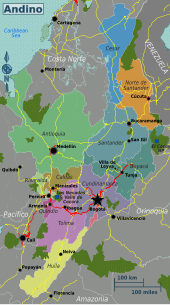 | |
| Biodiversity | aquatic birds | 14 | |
| amphibians | 485 | ||
| reptiles | 220 | ||
| plants | 11,500 | ||
| fish | 197 | ||
| References | |||
Orinoquía natural region[]
 |
Surface area | 285,437 km2 (110,208 sq mi) | hide |
| Departments | |||
| National parks | La Macarena El Tuparro |
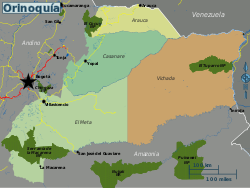 | |
| Biodiversity | aquatic birds | 92 | |
| amphibians | 57 | ||
| reptiles | 119 | ||
| plants | 2692 | ||
| fish | 619 | ||
| References | |||
Amazon natural region[]
 |
Surface area | 483,911 km2 (186,839 sq mi) | hide |
| Departments | |||
| National parks | 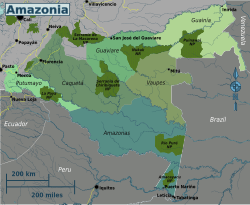 | ||
| Biodiversity | aquatic birds | 74 | |
| amphibians | 158 | ||
| reptiles | 195 | ||
| plants | 5300 | ||
| fish | 675 | ||
| References | |||
Pacific/Chocó natural region[]
 |
Surface area | 83,170 km2 (32,110 sq mi) | hide |
| Departments | 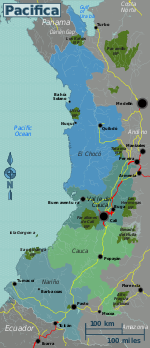 | ||
| National parks | Los Katíos Uramba Bahía Málaga Utría | ||
| Biodiversity | aquatic birds | 142 | |
| amphibians | 154 | ||
| reptiles | 177 | ||
| plants | 4525 | ||
| fish | 164 | ||
| References | |||
Insular natural region[]
 |
Surface area | 300 km2 (120 sq mi) | hide |
| Departments | 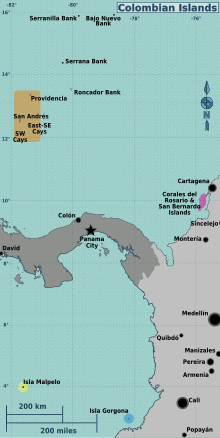 | ||
| National parks | Corales del Rosario Malpelo Old Providence Gorgona | ||
| Biodiversity | Corales del Rosario y San Bernardo | ||
| fish | 170 | ||
| corals | 52 | ||
| sponges | 25 | ||
| molluscs & crustaceans | 100s | ||
| Gorgona Island | |||
| fish | |||
| Malpelo Island | |||
| fish | Acanthemblemaria stephensi | ||
| Old Providence Lagoon | |||
| birds | 74 | ||
| References | |||
Biodiversity hotspots[]


Colombia hosts two biodiversity hotspots; the Tropical Andes and Tumbes–Chocó–Magdalena. The country is part of the World Network of Biosphere Reserves with five biosphere reserves:[27]
| Name | Since | First review |
Second review |
Image | hideNotes |
|---|---|---|---|---|---|
| Cinturón Andino | 1979 |
2001 |
2011 |
 |
|
| El Tuparro | 1979 |
2001 |
2011 |
 |
|
| Sierra Nevada de Santa Marta | 1979 |
2001 |
2011 |
 |
|
| Ciénaga Grande de Santa Marta | 2000 |
2011 |
 |
||
| Seaflower | 2000 |
2011 |
 |
Species[]

Selected fauna[]
| Name | Species | showImage |
|---|
Selected endemic flora[]
| Name | Species | showImage |
|---|
Selected endemic fungi[]
| Name | Species | showImage |
|---|
Panoramas[]
See also[]
- Biodiversity of the Eastern Hills, Bogotá
- Conservation biology
- Biodiversity of Thomas van der Hammen Natural Reserve
- Biodiversity of Cape Town, New Caledonia, New Zealand
- Biodiversity of Borneo, environmental issues in Colombia
- Environmental personhood
References[]
- ^ Jump up to: a b (in Spanish) Qué es la biodiversidad - Humboldt Institute
- ^ (in Spanish) Nuevo Parque Nacional Natural de Colombia Bahía Portete - Ministerio de Ambiente, Colombia
- ^ (in Spanish) Bahía Portete, regalo de Navidad - El Espectador
- ^ Colombia Viva:Informe 2017 - WWF-Colombia
- ^ "Instituto Humboldt". www.humboldt.org.co (in Spanish). Retrieved 2021-06-08.
- ^ Biodiversity A-Z
- ^ (in Spanish) Biodiversidad en Colombia
- ^ SiB, 2016, p.1
- ^ SiB, 2016, p.3
- ^ Five unmissable Colombian páramos begging to be explored
- ^ Nieto Escalante et al., 2010, p.75
- ^ Jump up to: a b c d e f g (in Spanish) Parques Nacionales de Colombia
- ^ Jump up to: a b c d e f g (in Spanish) Estadísticas Biodiversidad Colombia
- ^ Arbeláez Cortés et al., 2015, p.163
- ^ UNDP, 2014, p.18
- ^ Rodríguez Becerra, 2001, p.10
- ^ SiB, 2016, p.6
- ^ SiB, 2016, p.8
- ^ (in Spanish) Plan de acción de biodiversidad Colombia 2016-2030
- ^ (in Spanish) Biodiversidad nuestra conexión vital - Banco de la República
- ^ Woods, 2008, p.49
- ^ Kyne, P.M. (2016). "Pseudobatos prahli". IUCN Red List of Threatened Species. 2016: e.T63158A104002851. doi:10.2305/IUCN.UK.2016-3.RLTS.T63158A104002851.en.
- ^ Villa-Navarro, F., Mesa-Salazar, L., Sanchez-Duarte, P. & Lasso, C. (2016). "Trichomycterus gorgona". IUCN Red List of Threatened Species. 2016: e.T64792679A64890625. doi:10.2305/IUCN.UK.2016-1.RLTS.T64792679A64890625.en.CS1 maint: multiple names: authors list (link)
- ^ Bessudo, S., Dominici-Arosemena, A., Espinosa, H. & Hastings, P. (2010). "Acanthemblemaria stephensi". IUCN Red List of Threatened Species. 2010: e.T183968A8208246. doi:10.2305/IUCN.UK.2010-3.RLTS.T183968A8208246.en.CS1 maint: multiple names: authors list (link)
- ^ Allen, G., Edgar, G., Rocha, L. & Min, L. (2010). "Halichoeres malpelo". IUCN Red List of Threatened Species. 2010: e.T183519A8127170. doi:10.2305/IUCN.UK.2010-3.RLTS.T183519A8127170.en.CS1 maint: multiple names: authors list (link)
- ^ , and . 2007. Colombia Natural Parks. Villegas Asociados. Accessed 2017-01-30.
- ^ World Biosphere Reserves - Latin America & The Caribbean
- ^ Cinturón Andino - World Biosphere Reserve
- ^ El Tuparro - World Biosphere Reserve
- ^ Sierra Nevada de Santa Marta - World Biosphere Reserve
- ^ Ciénaga Grande de Santa Marta - World Biosphere Reserve
- ^ Sea Flower - World Biosphere Reserve
Bibliography[]
- ; ; ; ; , and . 2015. Colombian frozen biodiversity - 16 years of the tissue collection of the Humboldt Institute - La biodiversidad congelada de Colombia: 16 años de la colección de tejidos del Instituto Humboldt. Acta Biológica Colombiana, Universidad Nacional de Colombia 20. 163-173.
- ; ; ; ; ; ; , and . 2010. Geografía de Colombia - Geography of Colombia, 1-367. Instituto Geográfico Agustín Codazzi.
- . 2001. La biodiversidad en Colombia, 1-32. Accessed 2017-01-30.
- . 2016. Biodiversidad en cifras, 1-9. Sistema de Información sobre Biodiversidad de Colombia. Accessed 2017-01-30.
- . 2014. V Informe nacional de biodiversidad de Colombia - ante el convenio de diversidad biológica, 1-156. United Nations Development Program. Accessed 2017-01-30.
- . 2008. Colombia. Bradt Travel Guides. Accessed 2017-01-30.
External links[]
- (in Spanish) Biodiversidad Colombia - Universidad de La Salle
- Colombia: Bajo Caguán-Caquetá Rapid Inventory [PDF]
- Colombia: La Lindosa, Capricho, Cerritos Rapid Inventory [PDF]
- Environment of Colombia
- Lists of biota of Colombia
- Fauna of Colombia
- Flora of Colombia
- Endemic fauna of Colombia
- Endemic flora of Colombia
- Wildlife by country

